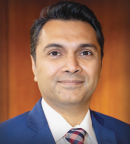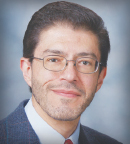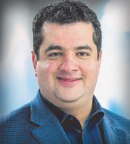The high-energy vibe at the 2022 American Society of Hematology (ASH) Annual Meeting and Exposition reflected the welcomed presence of enthusiastic on-site attendees and the high quality of the research presented. The ASCO Post has already reported in detail on many of these presentations, and now we also bring readers these quick summaries of other interesting findings.
Rapcabtagene Autoleucel in Diffuse Large B-Cell Lymphoma
Rapcabtagene autoleucel (YTB323), an autologous CD19-directed chimeric antigen receptor (CAR) T-cell therapy generated by the T-Charge™ platform, led to complete responses in almost three-quarters of patients with relapsed or refractory diffuse large B-cell lymphoma.1 The T-Charge platform produces CAR T cells by a rapid manufacturing process that takes 2 days and preserves T-cell stemness. “This translates into the potential to deliver deep and more durable clinical responses and a favorable safety profile,” said Pere Barba, MD, PhD, of the Hospital Universitari Vall d’Hebrón and Universitat Autònoma de Barcelona in Spain.

Pere Barba, MD, PhD
Dr. Barba presented efficacy, safety, dose exposure, and biomarker analyses for rapcabtagene autoleucel in 47 adults with relapsed or refractory diffuse large B-cell lymphoma in an ongoing phase I multicenter, dose-escalation study. Patients received single-dose rapcabtagene autoleucel at four targeted dose levels: dose level 1 (2.5 × 106 CAR-positive cells), dose level 2 (12.5 × 106 CAR-positive cells), dose level 3 (25 × 106 CAR-positive cells), and dose level 4 (40 × 106 CAR-positive cells). Median follow-up was 13 months.
Dr. Barba focused on outcomes achieved in dose level 2, which included the most patients and had the best efficacy-to-safety ratio. In this group of 30 patients, 22 (73%) achieved a complete response, and 3 achieved (10%) a partial response, for an overall response rate of 83%. Median duration of response was 16 months. At 12 months, 50% of patients were still in complete remission. “Notably, there were two patients with stable disease and one with progressive disease at first assessment, day 28, who converted to complete remissions with further treatment,” Dr. Barba added.
The safety profile was manageable, with 4% of patients experiencing dose-limiting toxicities and no deaths related to rapcabtagene autoloeucel. Cytokine-release syndrome developed in 11 patients (37%) but was low grade for 9 (30%) and resolved within a median of 6 days from onset. Immune effector cell–associated neurotoxicity (ICANS) was seen in 10%, which was grade 3 or 4 in 4%. The time to onset of both cytokine-release syndrome and ICANS was slightly longer than is typically seen, he noted.
“Rapcabtagene autoleucel expansion was robust. At a 25-fold lower dose, rapcabtagene autoleucel expansion at dose level 2 was at the higher end of tisagenlecleucel expansion in diffuse large B-cell lymphoma…. The kinetics measured showed robust expansion at dose level 2 and no further increases at higher doses,” Dr. Barba said. “Finally, the T-Charge manufacturing process preserved T-cell stemness and the CD4:CD8 ratio in the final product.”
The recommended dose for further study will be dose level 2 (12.5 × 106 CAR-positive viable T cells), he noted, “based on the complete response rate, favorable safety profile, and cellular kinetics.” Future studies will also assess “vein to vein” time, as this was not easy to determine in this study.
Imetelstat in Myelodysplastic Syndrome
In the phase II portion of the IMerge trial, the novel agent imetelstat led to prolonged, meaningful, and durable red blood cell transfusion independence across a broad range of heavily transfusion-dependent patients with lower-risk, non-del(5q) myelodysplastic syndromes relapsed or refractory to erythropoietin-stimulating agents but naive to lenalidomide or hypomethylating agents.2 Imetelstat is a first-in-class direct and competitive telomerase inhibitor that targets cells with high telomerase activity and human telomerase reverse transcriptase expression, both of which have been reported in myelodysplastic syndrome. Patients in the study received 7.5 mg/kg IV every 4 weeks.
Investigators previously reported that imetelstat led to a median duration of red blood cell transfusion independence of 65 weeks and even longer (median of 88 weeks) in 38 patients with non-del(5q) disease naive to lenalidomide or hypomethylating agents.3 Transfusion independence for 8 weeks was achieved by 42% of patients; 32% achieved 24-week transfusion independence; and 29% were transfusion-independent for at least 1 year.3

Uwe Platzbecker, MD
This 29% of patients (n = 11) was the subject of the current analysis, based on a median follow-up of 57 months, and reported by Uwe Platzbecker, MD, of Leipzig University Hospital in Germany. This subset represented 69% of patients with transfusion independence of at least 8 weeks and 92% with at least 24 weeks. An SF3B1 mutation was seen in 100% of the 11 patients; their median prior red blood cell transfusion burden was 6 units over 8 weeks; and the median treatment duration was 126 weeks over 27 cycles.
Median onset of 8-week transfusion independence in this subset was 9.3 weeks. However, “there was one patient whose transfusion independence started 40 weeks after treatment initiation, and, interestingly, patients who achieved transfusion independence but then had another transfusion event achieved subsequent transfusion independence,” Dr. Platzbecker noted.
Median progression-free survival was 34.2 months, and median overall survival was 56.1 months. None of the 11 patients experienced progression to acute myeloid leukemia. Of the nine patients with mutation information available, 89% had a reduction in SF3B1 variant allele frequency, and this correlated with a longer duration of transfusion independence and a shorter time to the onset of independence.
“We saw strong evidence of disease-modifying activity for imetelstat’s mechanism of action,” Dr. Platzbecker said. He cited the 92-week median duration of transfusion independence, robust increase in hemoglobin levels (≥ 3 g/dL), notable survival after disease progression on erythropoiesis-stimulating agents, and reduction in mutational burden.
The trial sponsor, Geron, recently announced positive results from the primary analysis of the phase III portion of IMerge in patients who were relapsed, refractory, or ineligible for erythropoiesis-stimulating agents, highly transfusion-dependent, and had not received prior treatment with hypomethylating agents or lenalidomide.4 Data are being submitted to medical meetings, and the company plans to submit a new drug application in mid-2023.
High-Dose Chemotherapy vs Standard Immunotherapy in Primary CNS Lymphoma
Progression-free survival and overall survival were significantly higher after high-dose chemotherapy compared with conventional immunotherapy in fit patients with newly diagnosed primary central nervous system (CNS) lymphoma, according to the results of the MATRix/IELSG43 trial.5
Despite similar remission rates after consolidation, findings from the international, randomized, phase III trial showed a 54% reduction in the risk of death with high-dose chemotherapy with autologous stem cell transplant vs conventional immunotherapy with the R-DeVIC protocol (rituximab, ifosfamide, dexamethasone, carboplatin, and etoposide).
“Results of the largest, randomized, multicenter, phase III trial investigating the impact of high-dose chemotherapy in untreated patients with primary CNS lymphoma not older than age 70 demonstrate that consolidation with high-dose chemotherapy and autologous stem cell transplant leads to significantly better outcomes than nonmyeloablative chemoimmunotherapy,” said Gerald Illerhaus, MD, of Klinikum Stuttgart in Germany. “This comes without any measurable negative effect on neurocognitive functions and with an excellent risk-to-benefit ratio.”

Gerald Illerhaus, MD
As Dr. Illerhaus explained, the treatment of primary CNS lymphoma is particularly challenging, given its aggressive nature and unique localization.
This open-label trial took place in 79 centers across 5 European countries (Germany, Italy, Denmark, Norway, and Switzerland). All patients enrolled on study were immunocompetent and had newly diagnosed primary CNS lymphoma.
Induction consisted of four cycles of the MATRix regimen (rituximab, methotrexate, cytarabine, and thiotepa). Patients achieving at least a partial response after completion of induction were randomly assigned to either two courses of the R-DeVIC regimen or high-dose chemotherapy with carmustine and thiotepa followed by autologous stem cell transplantation.
A total of 115 patients were randomly assigned to the R-DeVIC regimen, whereas 114 patients went on to receive high-dose chemotherapy. Overall responses were similar in both arms, with approximately 40% of patients achieving a complete response in each. However, with a median follow-up of 45.3 months, there was a 26% difference in progression-free survival favoring the high-dose chemotherapy arm (hazard ratio [HR] = 0.405; P = .0002).
High-dose chemotherapy was also superior in terms of overall survival. With a median follow-up of 45.3 months, 86% of patients randomly assigned to high-dose chemotherapy were alive vs 71% of patients randomly assigned to conventional immunotherapy (HR = 0.456; P = .0077). All subgroups showed an advantage with high-dose chemotherapy, an effect that was especially notable in younger patients, said Dr. Illerhaus.
To reduce toxicity during induction therapy, a shorter induction therapy with rituximab and methotrexate followed by two cycles of the MATRix regimen is being tested in the randomized OptiMATe trial.
Novel Graft-vs-Host Disease Prophylaxis
Regimen After Transplantation
A new graft-vs-host-disease prophylaxis regimen consisting of cyclophosphamide, tacrolimus, and mycophenolate mofetil improved 1-year graft-vs-host-disease relapse-free survival compared with tacrolimus plus methotrexate in patients with hematologic malignancies undergoing reduced-intensity conditioning allogeneic hematopoietic cell transplantation, according to the results of the BMT CTN 1703 trial.6
Findings from the phase III study showed that the group given the three-drug combination had a significantly lower hazard for graft-vs-host-disease relapse or progression-free survival and a higher adjusted 1-year graft-vs-host-disease relapse-free survival rate compared with the group given the two-drug combination.
“Based on these results, we believe that posttransplant cyclophosphamide, tacrolimus, and mycophenolate mofetil should be the standard graft-vs-host-disease prophylaxis in well-matched adult, reduced-intensity transplantation,” said lead study author Shernan G. Holtan, MD, of the University of Minnesota, Minneapolis.

Shernan G. Holtan, MD
As Dr. Holtan reported, the phase III BMT CTN 1703 trial enrolled 431 patients aged 18 or older with hematologic malignancies who were undergoing reduced-intensity conditioning, allogeneic hematopoietic cell transplantation and randomly assigned them to receive either the three-drug combination or the two-drug combination. The primary endpoint of the study was 1-year graft-vs-host-disease relapse-free survival and progression-free survival. Secondary endpoints included engraftment/chimerism, incidence and severity of acute and chronic graft-vs-host-disease, infections, relapse or disease progression, and survival.
Dr. Holtan and colleagues found that patients treated with post-transplant cyclophosphamide, tacrolimus, and mycophenolate mofetil had a significantly lower hazard for graft-vs-host-disease relapse compared with those treated with tacrolimus plus methotrexate (HR = 0.641; P = .001).
According to Dr. Holtan, the improvement in graft-vs-host-disease outcomes was due to a twofold reduction in severe acute and chronic graft-vs-host-disease in the triplet arm. At day 100 of the study, grade 3 or 4 acute graft-vs-host-disease occurred in 6.3% of patients receiving the three-drug combination compared with 14.7% of patients receiving the two-drug combination. Similarly, the rates of chronic graft-vs-host-disease requiring systemic immunosuppression at 1 year were 12.5% in the triplet group and 25.0% in the doublet group.
At 1 year, both groups had similar rates of relapse or disease progression (20.8% vs 20.2%; P = .906) and overall survival after transplantation (77.0% vs 72.2%; P = .252). However, graft-vs-host-disease–free survival was significantly improved among patients receiving the three-drug combination (61.9% vs 44.9%; P = .0004). Transplant-related mortality rates were also lower in the triplet arm (12.3% vs 17.2%; P = .167).
According to Dr. Holtan, further research is needed to confirm these findings and determine the long-term effects of this treatment regimen. The researchers are planning patient-reported outcome analyses and microbiota studies from their companion protocol, BMT CTN 1801.
Lisocabtagene Maraleucel vs Chemotherapy for Large B-Cell Lymphoma
The CAR T-cell product lisocabtagene maraleucel appears to be preferable to conventional second-line chemotherapy in patients with relapsed or refractory large B-cell lymphoma who are not candidates for hematopoietic stem cell transplantation, according to a comparison of outcomes from a phase II clinical trial of lisocabtagene maraleucel and real-world outcomes in patients treated with second-line chemotherapy.7
Lisocabtagene maraleucel achieved statistically significant favorable differences in adjusted overall response rates, complete response rates, duration of response, event-free survival, progression-free survival, and overall survival in an analysis adjusted for baseline characteristics in both the PILOT and real-world cohorts. In a separate sensitivity analysis that excluded patients treated with intent-to-treat transplant regimens, second-line lisocabtagene maraleucel was also significantly more effective than conventional second-line chemotherapy regimens in the real-world cohort.
“These results further support lisocabtagene maraleucel as an effective second-line therapy for patients with relapsed or refractory large B-cell lymphoma who are not intended for transplant,” stated first author Nilanjan Ghosh, MD, PhD, of Levine Cancer Institute, Atrium Health, Charlotte, North Carolina.

“These results further support lisocabtagene maraleucel as an effective second-line therapy for patients with relapsed or refractory large B-cell lymphoma who are not intended for transplant.”— Nilanjan Ghosh, MD, PhD
Tweet this quote
The poster presentation was based partly on data from the PILOT study, an open-label, single-arm, multicenter phase II study in 61 patients with relapsed or refractory large B-cell lymphoma not intended for transplant. Historically, these patients have poor outcomes and limited treatment options. PILOT showed that lisocabtagene maraleucel as second-line therapy achieved high response rates and durable responses.
The current study sought to compare the effectiveness of lisocabtagene maraleucel in the PILOT study vs an external control cohort of 273 patients with relapsed or refractory large B-cell lymphoma treated with conventional second-line chemotherapy in the real-world setting. All patients in the PILOT cohort received lisocabtagene maraleucel. The real-world cohorts were derived from data sets collected retrospectively from several sources across academic and community practices in the United States, Europe, and Japan.
The cohorts had similar baseline characteristics. Median patient age was 74, and about 78% were 70 or older. Stage III or IV disease was present in 66% of the PILOT cohort and 53% of the real-world cohort. The most common conventional second-line regimens in the real-world cohort were rituximab/ifosfamide/carboplatin/etoposide (15%), bendamustine/rituximab (12%), and rituximab/gemcitabine/oxaliplatin (11%). Other regimens were used in 61%.
Novel IDH1 Inhibitor in Resistant AML
The novel IDH1 inhibitor olutasidenib achieved durable complete remission in patients with relapsed or refractory acute myeloid leukemia (AML) as monotherapy, according to a planned interim analysis of the phase II 2012-HEM-101 trial conducted in patients with an IDH1 mutation, a subpopulation with a poor prognosis.8
The complete response rate was 32%, and complete response with partial hematologic recovery was documented in 3%. Median time to response was 1.9 months. An additional 10% of patients had a complete response with incomplete recovery, 2% had a partial response, and 1% had a morphologic leukemia–free status. No response was observed in 35% of patients.
“The observed activity [of olutasidenib] is clinically meaningful and represents a therapeutic advance in the treatment of this molecularly defined, poor-prognosis patient population with relapsed or refractory IDH1-mutant AML,” said lead author Jorge E. Cortes, MD, of the Georgia Cancer Center at Augusta University, Augusta, Georgia.

Jorge E. Cortes, MD
Olutasidenib is a potent selective oral small-molecule inhibitor of IGH1. The phase II trial built upon the phase I portion of the trial and enrolled 153 patients with relapsed or refractory IDH1-mutant AML. The safety evaluation included all 153 patients who had received at least one dose of olutasidenib. The efficacy-evaluable population included 147 patients with centrally confirmed IDH1 mutations who received the first dose of olutasidenib at least 6 months before the data cutoff; six patients who did not have centrally confirmed 1DH1 mutations were excluded from the efficacy analysis.
At baseline, 35% were refractory and 75% were relapsed. The median number of prior treatments was two; 97% had prior induction therapy, and 12% had prior hematopoietic stem cell transplantation. Two-thirds had primary de novo AML, and 34% had secondary AML. Cytogenetics were favorable in 4%, intermediate in 73%, poor in 17%, and unknown in 6%.
In the open-label, multicenter, phase II trial, olutasidenib was given at 150 mg twice daily in continuous 28-day cycles. At the time of data cutoff, 14% were still on treatment with olutasidenib. The overall response rate was 48%, with a median time to response of 1.9 months. Among 12 patients previously treated with venetoclax, complete response rates were similar to those of the overall efficacy-evaluable population.
A total of 73% of patients experienced an adverse event of any grade, and 39% had a grade 3 or 4 adverse event. Treatment-emergent adverse events leading to treatment discontinuation were noted in 31% of patients; they included disease progression in 14% and differentiation syndrome, febrile neutropenia, and pneumonia in 2% each. Among the 31% who died, most deaths were related to disease progression or complications.
Zanubrutinib vs Acalabrutinib in B-Cell Malignancies
Zanubrutinib appears to confer a benefit with an improved safety profile in patients with B-cell malignancies who were intolerant to acalabrutinib, according to results of an ongoing phase II BGN-3111-215 trial.9 In a small study of 18 evaluable patients, the disease control rate was 94% (response rates plus stable disease), and the overall response rate was 61%. Median time to best overall response was 3 months, and median time to first overall response was 3 months.
“It appears that patients intolerant to acalabrutinib can attain clinical benefit by switching to zanubrutinib,” said lead author Mazyar Shadman, MD, MPH, of the Fred Hutchinson Cancer Research Center, University of Washington, Seattle.

Mazyar Shadman, MD, MPH
Patients entered in cohort 2 of the trial had been intolerant to a prior Bruton’s tyrosine kinase (BTK) inhibitor. Of the 21 patients, 13 had chronic lymphocytic leukemia, 2 had small lymphocytic leukemia, 1 had mantle cell lymphoma, 2 had marginal zone lymphoma, and 3 had Waldenström’s macroglobulinemia. Cohort 1 comprised 57 patients who were intolerant to ibrutinib, and these patients were not included in this analysis.
The primary objective of this study was to evaluate safety, based on the recurrence of adverse events associated with acalabrutinib, and their severity. For adverse events of any grade reported with acalabrutinib,75% did not occur during zanubrutinib treatment. Of those that did recur, none that were severe on acalabrutinib recurred as severe on zanubrutinib. At a median follow-up of 8.6 months, the median duration of zanubrutinib treatment was 7.6 months. A total of 81% remain on study, and 76% were on treatment at the time of this report. There were five treatment discontinuations (24%) due to adverse events.
Among patients who discontinued acalabrutinib, two experienced recurrence of an acalabrutinib-associated adverse event. Of three patients who had the same adverse event with ibrutinib and acalabrutinib, two did not recur on zanubrutinib, and one was a lower-grade recurrence.
In cohort 2, median patient age was 73 years, and the median number of prior BTK treatments was two. A total of 95% had previous acalabrutinib monotherapy, and 5% had combination therapy with acalabrutinib. Grade ≥ 3 adverse events were reported for 19%; two patients had a decrease in absolute neutrophil count, which was the sole grade ≥ 3 event occurring in more than one patient. ν
DISCLOSURE: Dr. Barba has received honoraria from Allogene, Amgen, BMS, Kite/Gilead, Incyte, Jazz Pharmaceuticals, Miltenyi Biomedicine, Nektar, Novartis, and Pierre Fabre. Dr. Platzbecker reported financial relationships with Geron, Jazz, AbbVie, BMS/Celgene, Takeda, Novartis, Silence Therapeutics, and Janssen. Dr. Illerhaus reported financial relationships with Riemser Pharma and Roche Pharma. Dr. Holtan reported financial relationships with CSL Behring, Incyte, and Vitrac Therapeutics. Dr. Ghosh reported no conflicts of interest. Dr. Cortes reported financial relationships with Daiichi Sankyo, Pfizer, Novartis, Jazz Pharmaceuticals, BiolineRX, Takeda, BioPath Holdings, Telios, and Sun Pharma. Dr. Shadman reported financial relationships with Mustang Bio, Bristol Myers Squibb, Celgene, Pharmacyclics, Gilead Sciences, Genentech, AbbVie, TG Therapeutics, BeiGene, AstraZeneca, Atera Biotherapeutics, Genmab, MorphoSys/Incyte, Sound Biologics, Innate Pharma, Kite, Adaptive Technologies, Eli Lilly, Adaptimmune, Regeneron, Merck, Fate Therapeutics, and MEI Pharma.
REFERENCES
1. Barba P, Kwon M, Briones J, et al: YTB323 (rapcabtagene autoleucel) demonstrates durable efficacy and a manageable safety profile in patients with relapsed/refractory diffuse large B-cell lymphoma: Phase I study update. 2022 ASH Annual Meeting and Exposition. Abstract 439. Presented December 11, 2022.
2. Platzbecker U, Komrokji RS, Fenaux P, et al: Imetelstat achieved prolonged, continuous transfusion independence in patients with heavily transfused non-del(5q) lower-risk myelodysplastic syndrome relapsed/refractory to erythropoiesis stimulating agents within the IMerge phase 2 study. 2022 ASH Annual Meeting and Exposition. Abstract 459. Presented December 11, 2022.
3. Platzbecker U, Fenaux P, Steensma DP, et al: Treatment with imetelstat provides durable transfusion independence in heavily transfused non-del(5q) lower risk MDS relapsed/refractory to erythropoiesis stimulating agents. 2020 ASH Annual Meeting and Exposition. Abstract 658.
4. Geron announces positive top-line results from IMerge phase 3 trial of imetelstat in lower risk MDS. January 4, 2023. Available at https://ir.geron.com/investors/press-releases/press-release-details/2023/Geron-Announces-Positive-Top-Line-Results-from-IMerge-Phase-3-Trial-of-Imetelstat-in-Lower-Risk-MDS/default.aspx. Accessed January 19, 2023.
5. Illerhaus G, Maria AJ, Ferreri JM, et al: Effects on survival of non-myeloablative chemoimmunotherapy compared to high-dose chemotherapy followed by autologous stem cell transplantation as consolidation therapy in patients with primary CNS lymphoma: Results of an international randomized phase III trial (MATRix/IELSG43). 2022 ASH Annual Meeting and Exposition. Abstract LBA-3. Presented December 13, 2022.
6. Holtan SG, Hamadani M, Wu J, et al: Post-transplant cyclophosphamide, tacrolimus, and mycophenolate mofetil as the new standard for graft-versus-host disease prophylaxis in reduced intensity conditioning: Results from phase III BMT CTN 1703. 2022 ASH Annual Meeting and Exposition. Abstract LBA-4. Presented December 13, 2022.
7. Ghosh N, Sehgal AR, Liu FF, et al: Comparative effectiveness of lisocabtagene maraleucel in patients with relapsed or refractory large B-cell lymphoma for whom transplant was not intended versus conventional second-line chemotherapy regimens in the real world. 2022 ASH Annual Meeting and Exposition. Abstract 4678. Presented December 12, 2022.
8. Cortes JE, Fenaux P, Yee K, et al: Olutasidenib (FT-2102) induces durable complete remissions in patients with relapsed/refractory mIDH1 acute myeloid leukemia: Results from a planned interim analysis of a phase 2 clinical trial. 2022 ASH Annual Meeting and Exposition. Abstract 2757. Presented December 11, 2022.
9. Shadman M, Flinn IW, Kingsley EC, et al: Zanubrutinib in acalabrutinib-intolerant patients with B-cell malignancies. 2022 ASH Annual Meeting and Exposition. Abstract 1587. Presented December 10, 2022.

